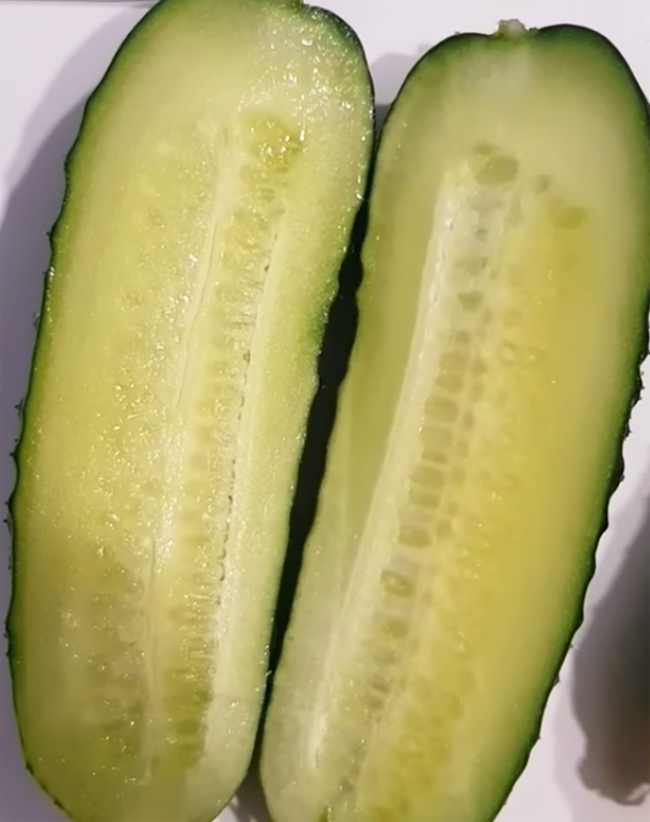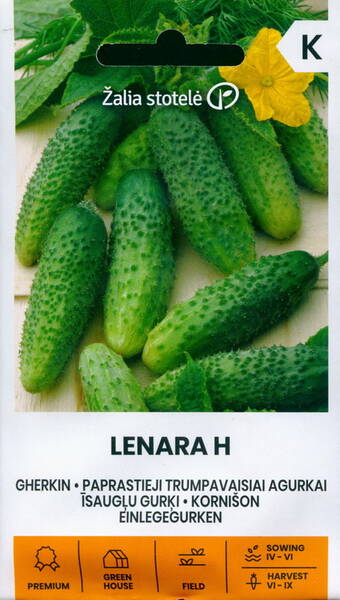Plants are vigorous, medium climbing, generative type, exclusively with female flowers, with shortened internodes and short stepchildren.
The leaves are dark green and medium in size. The ripening period is 38-40 days.
In one leaf sinus, Lenara has 2-3 fetuses. For better fruiting, you should ventilate the greenhouse more often and do not thicken the plantings.
Cucumbers are cylindrical in shape, with small tubercles and a short neck, 11-13 cm long, weighing 110-120 grams. The fruit length-to-diameter ratio is 3:1.
The skin is of medium thickness, rich dark green colour (darker at the base, lighter at the top) with short white stripes.
Medium density pubescence. Spikes are white.
The pulp is crispy and dense. Tasting taste score - 4.2 points.
The yield of marketable fruits is 17 kg/m2.
Marketable output - 90%.
The hybrid is resistant to olive blotch (cladosporiosis), powdery mildew and cucumber mosaic virus.
It has a powerful root system and increased shade tolerance, thanks to which it can be grown in winter-spring turnover. When overgrown, the fruits do not barrel, but a slight thickening appears at the top. Plucked fruits do not lose their presentation within 4-5 days.
Advantages of the hybrid: high yield and taste, excellent keeping quality and disease resistance.

* Cucumbers. Plant care.
Planting cucumber seedlings under film frame shelters or in a film greenhouse begins in the first half of May, in open ground on ridges - in the 1st decade of June.
Plants are planted on the ridge in two rows in a checkerboard pattern, the distance between the rows is 60-70 cm and between plants in a row 20-30 cm. After planting the plants, wire frames are installed over the bed and a film is stretched over them.
In the greenhouse, a wire is pulled over the ridge at a height of 1.8-2 m, to which the plants are tied with twine 2-3 days after planting. After the top of the plant reaches the wire, it is directed downwards.
Plants in the greenhouse need to be shaped.
In bee-pollinated, short-stemmed varieties, side shoots are removed only from 2-3 lower nodes, the remaining shoots are evenly distributed along the trellis. The central lash is pinched only if the formation of lateral lashes is delayed: after all, the main crop is formed on the lashes of the first and second order.
In parthenocarpic varieties, all flower buds and side shoots are removed from the stem at a height of 50 cm from the ground. Up to a plant height of 1.0 m, the side shoots are pinched, leaving 1 ovary - 1 leaf; up to a height of 1.5 m, 2 ovaries - 2 leaves are left on the side shoots, and then - 3 ovaries and 3 leaves.
Watering.
Cucumbers should be watered in warm, dry weather. On cold days, watering is harmful. Before flowering and the formation of ovaries, watering should be moderate, otherwise, increased growth of the vegetative mass will begin and the appearance of female flowers will be delayed. In hot weather, watering on the leaves of plants is unacceptable - this can cause severe burns to the leaves. It is best to water cucumbers in the morning or evening. From the beginning of fruiting, watering is carried out regularly, since 20-27 liters of water are consumed to produce 1 kg of fruit.
Features of caring for cucumbers.
- in cloudy weather, more potassium fertilizers should be given, reducing nitrogen ones;
- in high-light conditions, nitrogen fertilizing is increased;
- at low soil temperatures it is necessary to increase the dose of phosphorus fertilizers;
- in sunny weather, the number of fertilizing is increased, in cloudy weather - reduced;
- during the flowering period, leaf growth slows down, so the dose of nitrogen must be reduced, but the dose of potassium must be increased;
- once a month it is necessary to water the soil in the greenhouse with the following solution: 1 cup of ash or 0.5 cup of chalk per 10 liters of water. A liter of such a solution is poured onto 1 m2;
- the appearance of roots on the soil surface indicates that it is necessary to add soil with a layer of 2-3 cm for the growth of lateral roots of plants.
When caring for plants, it is necessary to pay attention to the colour of leaves and fruits, since it is associated with a lack of certain nutrients.
Lack of nitrogen.
The plants grow weakly, the leaves are pale green in colour. Gherkins are light green in colour, unusual for this variety, with a pointed upper part. It is recommended to water the plants with a solution of ammonium nitrate (3 tablespoons per 10 liters of water).
Lack of phosphorus.
The leaves are small, dark green and the edges of older leaves turn brown. The ovaries often fall off, sometimes even when fertilized (5 tablespoons of superphosphate per 10 liters of water).
Potassium deficiency.
A dry border appears along the edges of the leaves, and a dark brown film appears between the veins of the leaves. The fruits are green, but narrowed towards the stalk and greatly expanded towards the apex (3 tablespoons of potassium sulfate per 10 liters of water). For better growth and development, cucumber plants need to be periodically fed with complex mineral fertilizer.
Harvesting.
Cucumbers should be collected every 2-3 days. In cloudy and cool weather - less often. Irregular harvesting reduces the yield and marketability of greens. Hooks and other ugly fruits also need to be removed. For canning and pickling, it is better to use fruits from the same collection.












